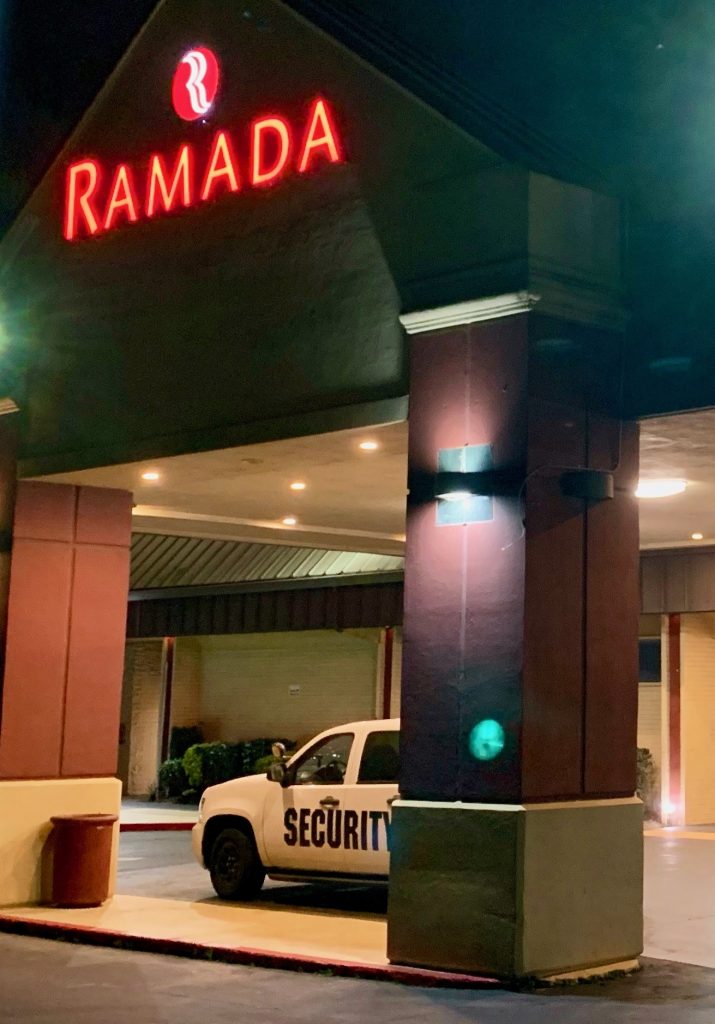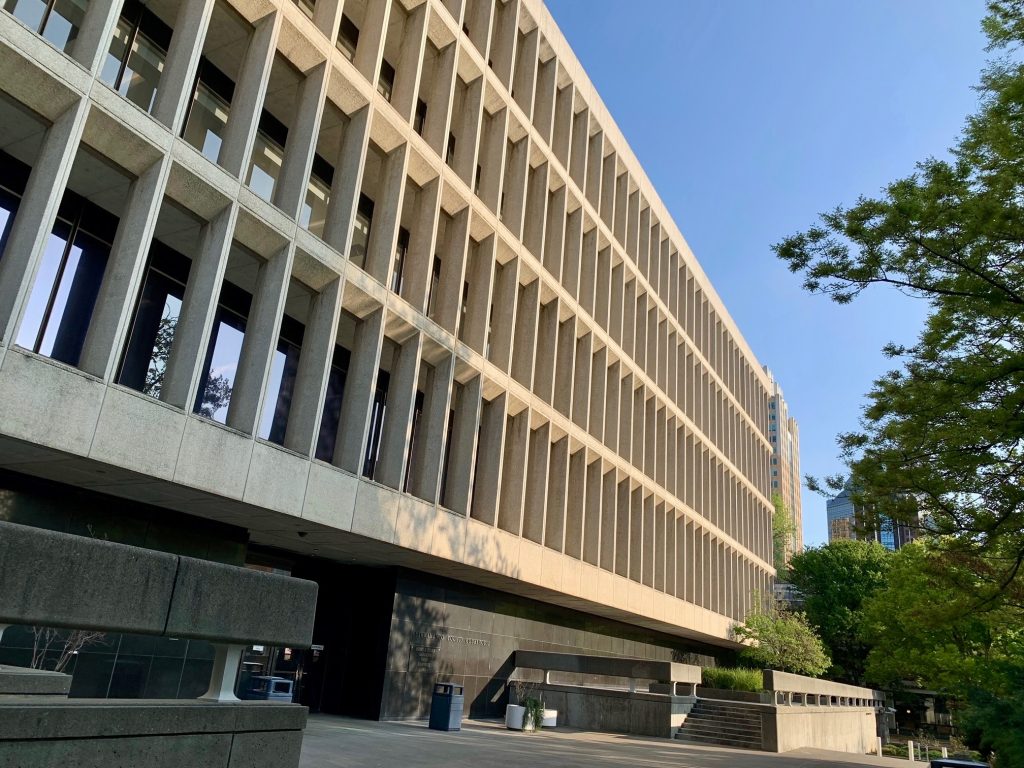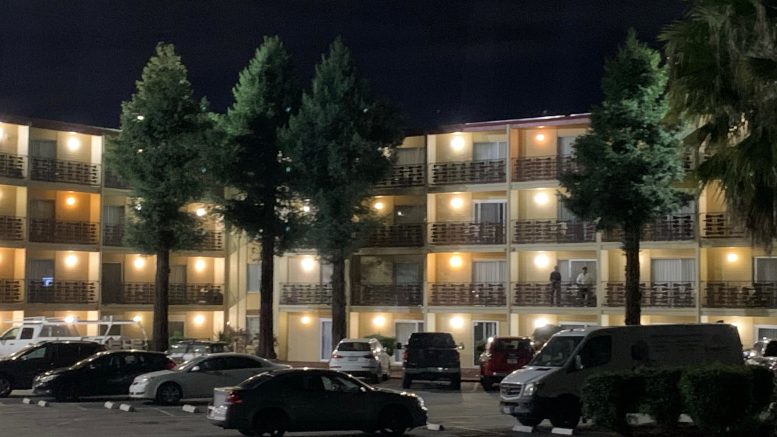It was New Year’s Eve, 2019, and people were gathering at North Sacramento’s Ramada Inn to toast a coming decade.
The minutes were counting down to 2020 – a year the world would never forget; but for those celebrating in a large parking lot near the corner of Auburn Boulevard and Fulton Avenue, the reality of death would arrive much sooner than the looming pandemic.
It manifested in a truck rolling up with its lights off, then two silhouetted figures approaching – then a pair of guns blazing away.
Three partiers went down.
At 1:07 a.m., Sacramento Sheriff’s deputy Silver Paley was alerted to shots fired at the Ramada. He drove to the hotel, navigating his patrol vehicle through a swarm of pedestrians and cars trying to leave the area. The deputy located a bleeding man on the ground 20 yards from the hotel’s front door. Bystanders were administering CPR. Paley learned that two other victims had also been shot, and at least one was driven to a nearby hospital. Both of those people would survive. But the 23-year-old Paley was taking over CPR duties on would not.
As the deputy worked, there was spattering of .9 millimeter shelling casings on the pavement nearby, along with some .40 caliber casings in another area.
Paley noticed an extremely upset man walking around the crime scene. Someone mentioned he was the victim’s brother, Zoey. It was from Zoey that law enforcement learned the man beginning to fade away on the ground was Hubert Calimee.
But a resolution to Calimee’s story – to his family’s ordeal – wouldn’t come with time. And it still hasn’t come yet.
Here’s the established timeline:
Hubert Calimee was murdered in the first minutes of 2020.
Within three weeks, law enforcement arrested two suspected shooters and an alleged getaway driver. Within three months, a judge found enough evidence to hold all three men to answer at a full murder trial.
Now, in the spring of 2025, that trial still has not happened.
The alleged gunmen have been in custody at the Sacramento Jail this entire time without seeing a jury, while the reported driver took a plea deal to end his legal saga.
As of this publication, there is still no trial date scheduled.
“It’s extremely unusual,” said Gabriel Chin, an independent expert in criminal producer and Martin Luther King Jr. Professor of Law at U.C. Davis. “There would have to be some special reason, or set of reasons, for a case to go on five years.”
While Chin isn’t familiar with the details in Calimee’s homicide, he notes, in general, there are reasons the California judicial system tries to avoid such lags.
“Obviously it’s bad for the victims’ families to be in limbo all this time, as well as the defendants’ families,” Chin observed. “There is an interest in resolving a case like this one way or another, sooner rather than later, because it’s bothering a lot of people – it’s a nagging presence in a lot of peoples’ lives beyond the defendants … Another reason that it’s bad for society is that cases get worse, as a general rule, as time goes by. That’s because memories fade, witnesses die, witnesses move away. And all things being equal, it’s better to get the case resolved while memories are still fresh.”
Three gangs, three victims

On the first day of 2020, Sacramento Sheriff’s deputy Mario Mendez walked into Kaiser North to speak with a survivor of the Ramada shooting. The man he was meeting was 32-year-old Willie Bryant.
Three months later, Mendez would testify in a preliminary hearing about the conversation he and Bryant had at the hospital.
According to that exchange, Bryant and a few lady friends had gone to the Ramada on New Year’s Eve “trying to look for a party.” While checking the scene out, Bryant ran in to Hubert Calimee. The men had known each other for six years, though they lived in different parts of town.
“Did [Bryant] tell you they were even from different gangs?” Deputy District Attorney Kristen Andersen asked Mendez on the witness stand.
“Yes mam,” Mendez replied. “Mr. Bryant told me he was from Starz, and Mr. Calimee was from the Oak Park Bloods … He stated that, although they were from different gangs, they were still able to maintain a good friendship.”
Bryant and Calimee may have been solid with each other, but reputed members of a third gang were also at the Ramada that night – and the vibes coming from them weren’t as uplifting.
At the hospital, Bryant recalled what Calimee mentioned about the brewing tensions: “He told me there as a funk.” That’s how Bryant put it. He knew the situation was edgy, but the next thing that actually popped off was a new year.
Bryant recalled celebrating in the parking lot with a group of about 25 people. He strolled over to a car to grab a bottle of Hennessy. He opened it, and, as he pulled its cork out, a series of explosions erupted.
“Mr. Bryant ran to see what was going on and where the gunshots were coming from,” Mendez testified, “and that’s when he noticed that Mr. Calimee had gotten shot; and he stated that his body spun around when he got shot … He stated that he had seen someone standing in front of the vehicle with no lights. They were dressed in all black. He stated it was a Black male; and he had only seen the flash of the muzzle.”
“After he saw Mr. Calimee get hit, what did [Bryant] do?” Andersen asked.
“He felt his friend get shot in the right part of his chest while he was pushing him to get out of the way,” Mendez went on. “As he tried to pull his friend to safety, he felt a warmth in his arm and realized he’d been shot, too.”
“And what did he tell you about what he realized about Mr. Calimee?” Andersen probed.
“His friend was not responding,” Mendez remembered. “He was trying to get [Calimee’s] attention, and then noticed there was smoke coming off his chest.”
Bryant may have witnessed an upsetting sight, but ultimately the professed member of Starz, a longtime South Sacramento gang, was not veering from the standard street code.
“He didn’t know who the shooter was,” Mendez told the court. “Mr. Bryant stated that, even if he knew who was involved, or who the shooter was, that he wouldn’t cooperate with law enforcement or tell me the information.”
Detectives from two agencies engage

Three people shot. One dead. Sacramento Sheriff’s homicide detectives immediately went to work.
According to the preliminary hearing, license plate-reading technology in the area identified a vehicle potentially linked to the killing. At the same time, elements of the murder were captured on different video feeds at the hotel. The Sheriff’s investigators could see a number of men moving through the hotel’s parking lot as the gunfire erupted. They also obtained video footage from Rainbow Market, a store where people were mustering before the violence about three miles away away near Grand Avenue.
Sheriff’s Homicide sent some of those images to Sacramento police gang detective Chad Lewis, an expert on the Del Paso Heights Bloods.
Lewis testified that the Ramada and Rainbow videos captured a handful of validated members of the Del Paso Heights Bloods partying on the New Year’s Eve. One of them, he detailed, was Alizey Whitfield.
Soon, Sheriff’s detectives John Rodriguez and Vitaly Prokopchuk were contacting Whitfield. The alleged Blood admitted that he and his brother, Robert Massingale, were at the Ramada Inn that night, having arrived in Massingale’s truck.
“He initially said he was either drunk or high,” Rodriguez testified. “Then, later in the night, they heard gunshots and scurried off.”
“And did he deny being involved in the murder of Mr. Calimee?” Andersen asked.
“He did,” Rodriguez confirmed. “He denied it.”
But by then, detectives knew from video surveillance that Whitfield and Massingale had been walking around the Ramanda with two other people, Darquan Jackson and his then-girlfriend. SN&R is not naming the girlfriend, though Rodriguez and Sheriff’s detective Kevin Lawrence tracked her down. The girlfriend acknowledged she’d been with Jackson, Whitfield and Massingale that night, first at the Rainbow Market and then at the Ramada Inn.
The girlfriend remembered being inside the hotel, dancing with Jackson as the new year approached. Then she noticed Whitfield and Massingale suddenly walk over. They whispered something in Jackson’s ear.
“She stated that it kind of changed the mood a little bit,” Rodriguez explained. “Mr. Jackson had went outside, and while he was getting ready to walk outside, a firearm – a handgun – had fallen from his pocket.”
During the investigation, Detective Lewis also validated Jackson as a member of the Del Paso Heights Bloods.
At the preliminary hearing, Lawrence walked the judge through what he asserts the hotel videos capture next: He said the images frame Jackson, Whitfield and Massingale coming out of the Ramada, along with two other members of the Del Paso Heights Bloods, and approach another group of people. Lawrence referred to the second cluster of individuals as “the victim group,” which presumably included Hubert Calimee.
Lawrence testified that Jackson, Whitefield and Massingale are then depicted walking over to Massingale’s truck in the parking lot: They get inside it before the vehicle starts rolling over towards “the victim group.”
“What does defendant Whitfield do?” Andersen asked.
“He approaches the victims, pulls up his – looks like he’s wearing a sweater – and retrieves a firearm from his waistband,” Lawrence answered. “And he begins shooting towards the victims.”
“And where is Jackson at this point?” Andersen continued.
Lawrence replied that Jackson was approaching the victim group, too, but was hit by a Lyft driver in a sedan. According to the detective, the video shows Jackson get knocked to the ground, get up again, and then start firing his gun.
Minutes before the bullets were flying, Jackson’s girlfriend had been walking away from the hotel. She would remember not seeing the gunplay, only hearing it ring out.
Was that the end of her night?
No, Rodriguez said on the stand.
“Mr. Jackson contacted her by cellular phone,” the detective added. “He told her to shut the fuck up.”
A January 2020 murder that hasn’t gone to trial in 2025

If Hubert Calimee was an alleged member of the Oak Park Bloods, why was he targeted by reputed members of the Del Paso Heights Bloods?
Lawrence told the judge that he’d found social media posts that were spreading rumors Calimee had “snitched” on Whitfield in a Sacramento Police Department report.
Sheriff’s detectives executed search warrants at the apartment where Jackson lived on Marconi Avenue near the Del Paso Country Club, as well as Whitfield’s residence on Woodland Avenue, which added more pieces of evidence to their case.
The preliminary hearing ended with Jackson, Whitfield and Massingale all being bound over on murder charges.
Massingale, a suspected accessory, later took a plea deal.
The legal action began to slow.
SN&R has since attended numerous court dates for Jackson and Whitfield over the years. Our review of court records indicates that Jackson and Whitfield’s murder trial has been delayed or rescheduled at least 16 times. As of publication, there is not even a new date set for the trial: The defendants’ next scheduled appearance in the Downtown Jail court department is simply logged in the system as “further proceedings.”
All criminal defendants have a guaranteed right to a speedy trial. It is enshrined in Sixth Amendment of the U.S. Constitution and directly stated in the California Constitution. Whitfield and Jackson have been routinely waving that right, presumably on the advice of their attorneys, but county records indicate they’ve been held in custody in the Sacramento County Jail this entire time – since January of 2020 – without a jury finding them guilty of a crime.
Whitfield’s original defense attorney, Martin E. Tejeda, exited the case at one point and became a Sacramento court commissioner, though that type of lawyer-shuffling isn’t too unusual in multi-defendant cases; and it alone certainly doesn’t explain why there’s still not even a scheduled trial date in 2025.
The case against the alleged Ramada shooters may be substantial, but a conviction at trial is not guaranteed. A number of Sacramento gang members have been acquitted by juries in past shootings. SN&R has also interviewed local defense lawyers who object to the gang validation process used by police and sheriff’s deputies. Indeed, during Jackson and Whitfield’s preliminary hearing, Jackson’s attorney, Michelle Trigger, repeatedly pushed back against how the validation process was applied to her client.
Jackson is entitled to see a similar showdown between Trigger and the detectives in front of a jury, but so far, it just hasn’t happened.
Repeated attempts by SN&R contact Trigger were unsuccessful. SN&R also requested an interview with Sacramento County District Attorney Thien Ho about the delays in this case. That interview was not granted; but the DA’s Office did issue this statement: “Complex multiple defendant cases can take some time to get to trial. While we have been ready to proceed, other factors can and have contributed to significant delays. An original defense attorney on this case unfortunately passed away, which required appointment of new counsel. Then, another defense attorney was appointed by the Superior Court to be a commissioner, which (again) caused another attorney to be appointed. This was another delay beyond our control. It is our hope to move this case along as quickly as possible.”
Numerous California law firms specializing in criminal defense have published their own analytic breakdowns about acceptable timeframes for resolving a felony case. In the aggregate, the general consensus among defense attorneys is three months to three years.
Professor Chin said that estimate is reasonable.
“Two, three, four, five, six, seven months for a good reason is one thing, but defense attorneys aren’t going to be able to delay things indefinitely,” Chin pointed out. “One could say, in general, ‘justice delayed is justice denied,’ and, in general, five years for a homicide is way too long. But on the other hand, if there is some good reason, it might be that the case is proceeding with all deliberate speed.”
Scott Thomas Anderson is also the writer and producer of the true crime documentary podcast series “Trace of the Devastation.”
Editor’s note: This story was updated April 3 to include a statement from the Sacramento County District’s Attorney’s Office an earlier version of the posted story did not have.


Be the first to comment on "Sacramento sheriff’s detectives made multiple arrests in a gang shooting spree and murder. Five years later, the case still hasn’t gone to trial"